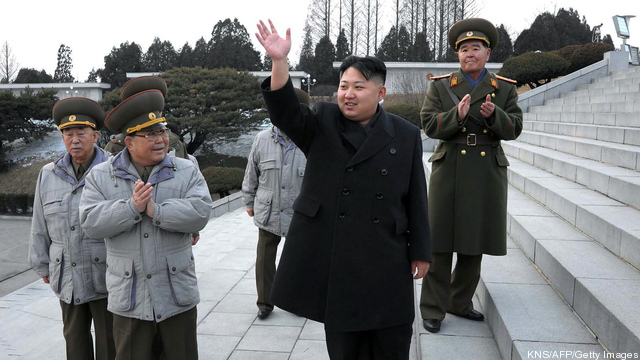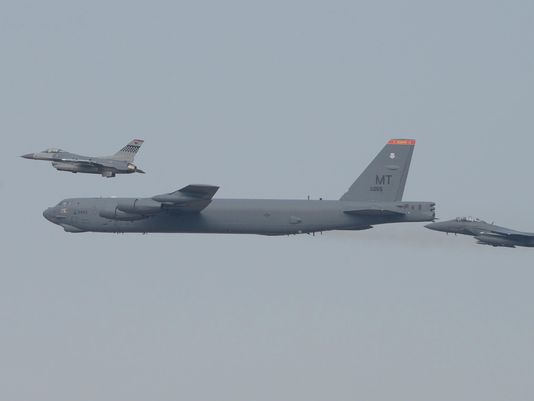Preparing for The Next War in Korea
Posted on

North Korea’s young leader, Kim Jong-un.
Preparing for war can sometimes help prevent one, and those preparations are probably helpful if one does start. Perhaps it’s time to show North Korea what its forces would be in for, and to show our allies in the South that we are with them, seriously.
The best course may be through field exercises conducted jointly by US and South Korean conventional forces, demonstrating operational capabilities to be used in the face of nuclear strikes.
Often a second Korean War is imagined to end with US nuclear weapons destroying the North. True, this year United States has twice flown bombers over South Korea, perhaps to make sure that Kim remembers we have them. But it seems improbable that the US would use nuclear weapons in a war against the North, even if Kim Jong Un started the war by using atomic bombs.

B-52 flies low near North Korea Jan. 2016
The reason has little to do with postulated norms or taboos or risks of escalation. It’s just that we might well find there is nothing in our arsenal that is militarily appropriate. Presumably, we would want weapons with low yield, minimally persistent radiation, and enhanced electromagnetic effects, and that are targetable with tactical precision. The best available option in the near term would be a low-yield B61-12 delivered by a bomber, but radiation levels of the wrong kind could prove higher than desired. And if North Korea had some advanced Russian air defense systems, we might lose some pilots and aircraft.
Of course, we could develop nuclear weapons that are tailored to such specific eventualities, an option that in the past has attracted both US and Russian military planners. But the domestic political context in Washington is not likely to support this approach, because it would require reversing policy strictures against design and test that the government has observed for many years.
Moreover, there are many people who oppose making nuclear weapons more appropriate to a broader range of military objectives, fearing that such weapons are more likely actually to be used. In any event, nuclear explosions, however tailored and modernized, might not be the weapon of choice, considering the difficulties they would create for continuing operations and escalation control, as well as war termination and reconstruction.
The United States needs to be able to deal militarily with lesser nuclear powers without using nuclear weapons even if the other side does, a need that has long been recognized. At the end of 1993, Defense Secretary Les Aspin noted that “nuclear weapons can still be the equalizer against superior conventional forces. But today it is the United States that has unmatched conventional military power, and it is our potential adversaries who may attain nuclear weapons. We’re the ones who could wind up being the equalizee.”
Pursuant to President Clinton’s direction (PDD-18), the Defense Department set out to reinforce traditional non-proliferation activities with options for action when proliferation had already occurred. These options were developed under the rubric “counter-proliferation,” and they included developing general purpose forces that could operate under nuclear attack. In addition to meeting a wider range of contingencies, such forces can help ameliorate allied worries about shared views of regional deterrence (South Korea, for example, has posed sharp questions about American deterrence in the face of repeated North Korean attacks, particularly the 2010 sinking of the Cheonan and the shelling of Yeongpyeong Island).
If allies followed suit, equipping and training their own general purposes forces for conventional military operations in a nuclear environment, they might feel more secure about decisions affecting their strategic interests and more capable of responding to provocations. Those provocations, in turn, might become less serious when American military involvement is somewhat less immediate. While such diplomatic and military adjustments would take thought and care, the emphasis on non-nuclear forces and options could substantially reduce the uncertainties inherent in extended deterrence.
The “counter-proliferation” policy as envisioned in 1993 did not lead to a vigorous program. Questions arose almost immediately about the roles, missions, and budgets implied by the new initiative and how it was to be coordinated with policies and programs already ongoing under the rubric of nonproliferation. Semantic and ad hoc resolutions of these questions continue, but we still lack the military capability envisioned by Aspin.
As reported by the Defense Science Board in 2005, “the bottom line is that commanders and planners cannot be assured that today’s weapons platforms, command and control (C2), intelligence, surveillance and reconnaissance (ISR), and associated support systems will be available should a nuclear detonation occur.” The Board reported again, five years later, that “for nearly two decades, nuclear survivability via hardening of equipment and/or operational contingencies to enable “fighting through” [by General Purpose Forces] has been neglected.” After another year’s work the Board found that “the survivability, effectiveness, and adaptation of [General Purpose Forces] to [nuclear weapons effects] is at best unknown. If [General Purpose Forces] were subjected to a nuclear event in the foreseeable future, mission execution would depend upon combinations of luck and ingenuity in workarounds for failed equipment.”
Unless and until these deficiencies are corrected, the US military will present the president not with options and capabilities, but with a dilemma: use nuclear weapons that might not work, or conventional ones that will probably fail.
Subscribe to our newsletter
Promotions, new products and sales. Directly to your inbox.
